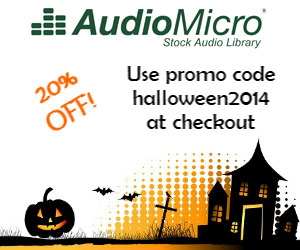 AudioMicro is having a promotion for Halloween sound effects and/or royalty-free music.
AudioMicro is having a promotion for Halloween sound effects and/or royalty-free music.
These are perfect for using in your Halloween videos, productions or haunted houses. Or just play them on your front porch or out the window to add to the spook of your house for all the trick-or-treaters:).
CLICK HERE for Horror Sound Effects. Then get 20% off by entering promo code halloween2014 at checkout!
CLICK HERE for royalty-free Halloween Music, and do the same as above – put halloween2014 in for the promo code at checkout.
royalty free music
Halloween Sounds
 Get Your Scary Halloween Sounds
Get Your Scary Halloween Sounds
Blastwave FX has a huge collection of high-quality, royalty-free scary sound effects for frightening, well, anyone you want. Scare the trick-or-treaters, co-workers, family members, and party-goers with these awesome sounds.
See below links to check out and download any of the 9 Horror Sound Effects Download Packs ($25 each).
Or get a 199-sound Horror Sounds library. That one comes on a flash drive since that amount of high-quality audio would be too much to download, so be sure to order this one early!
 |
 |
 |
 |
What Is Royalty Free Music and How Can I Use It?
Royalty free music is audio that you can use in your productions, usually behind a voice over recording, or as part of a video. There. Shortest article ever. Oh, you’d like a bit more information? Well, if you insist.
Is It Free?
Great question! This comes up a lot because the word “free” appears right in the name. The English language is a funny old thing. The word “free” does not actually mean “costs no money.” It’s just that English speakers have used it this way for so long, it has taken on that meaning to most people. According to Princeton’s on-line dictionary, the word actually means “not hampered; not under compulsion or restraint.” When we hear something like “free beer,” what it actually means is “beer that is free of charge.” This particular beer is “not hampered or constrained” by a “charge” of money. So what does this have to do with royalty-free music? Looked at in this way, the term becomes more clear as meaning “music that is free from the constraint of royalty charges.” Put another way, it means that the music can be used legally and the copyright owner of the music does not require royalty payments when someone else uses the music.
I encourage you to review copyright law http://www.copyright.gov/ for more information on royalties. But for now, you may be noticing that I didn’t answer the question of whether royalty-free (RF) music is free. The answer is…not usually. It’s like anything else. Providers are businesses who charge for their products, though sometimes they give them away. The same is true for RF music. There are many providers on the web.
Once you have purchased the music from them, you are free (no pun intended) to use it in your media productions without having to worry about being charged more royalties or about being sued for copyright infringement. However, there is usually an agreement for the use of RF music forbidding things like turning around and selling the music to someone else, claiming copyright ownership of the music, etc. Be sure you understand the terms of providers on the web.
So How Can I Use It?
If you can’t sell it and you can’t claim it, what CAN you do with it? You can use it in combination with other media in your productions. For example, if you have a podcast episode that needs music for the intro and outro, you can add the RF music to your podcast audio. If you need background music for a video you’re producing, you can add RF music to your video.
No, I mean HOW Can I Use It?
Oh, you mean “how do I add music to my podcast or video?” If you’re doing video, you’ll likely find that your video program (even Windows Movie Maker) has an “audio track” underneath the video track. You simply paste or drag your audio file into that track. With audio programs, you have to make sure you have “multi-track” capability. For example, the free audio program called Audacity, allows you to stack multiple audio tracks on top of each other. So you put your narration on one track, then add another track and put the RF music on that one. Then you adjust the volumes of each track to mix it together. After that, you render the result as a single stereo file. Not all audio programs do multi-track, though. For example, audio editors typically focus on mono or stereo files with one track only. Make sure you check this.
So to summarize, royalty-free music is a fantastic way to add spice, emotion, impact, etc. to your audio or video productions. But it usually is NOT “free of charge.” You still have to buy the music most of the time. But once you own it, you’re free to use it in your productions without paying royalties to the copyright owner. If you’d like to try out some RF music “free of charge,” come to the Home Brew Audio website. You’ll find some free music and tutorials on how to use it in your own audio production.
What Is Royalty Free Music? Spice Up Your Voice-Over With Background Music

What is royalty free music? Is it free? Do I need some?
To answer those questions in order:
- You’ll find out in this post
- No (at least not usually)
- Yes
So What Is Royalty Free Music?
It is music you can download and use in your recordings without having to worry about violating copyright.
The reason for that is that royalty free music has already been approved to be used in this way. The license has been approved for anyone to use.
Why Would I Want Royalty Free Music?
One way to truly give voice-over audio a professional edge is to put some background music behind it. It has never been easier or less expensive to obtain high quality music files to use in your productions. There are background music downloads and even free royalty free music all over the web these days.
So you’re sold already huh? You’re already on to “how do I get me some?”
OK, since it is so easy and quick…just go to Google and type in “royalty-free music,” and you’ll be presented with tons of links to sites where you can download program music. Or try one of my favorites, Shutterstock Music or AudioMicro. Some will cost a few bucks per file, some will be free. There. Go play.
What Does Royalty Free Mean?
For the rest of you there may be more questions…such as “what does royalty-free mean?” or “is it legal to use someone else’s music in my productions?” Good questions! “Royalty-Free” means that you do not have to pay royalties to use this music in your production, as you normally would if you wanted to use someone else’s music.
For example, you cannot just use an mp3 of a Beatles song in your podcast without paying royalties to the publisher. Good luck! With royalty-free music, there is no such hassle. You should read the fine print though. There are usually restrictions on things like turning around and selling someone else’s file of RF music on its own, say as part of a collection of RF music. As long as you add something to it, like a voice narration, etc. you should be fine.
Another burning question you may have is: “what are some good uses of RF music?” Another good question. One very common use is as background for a voice narration for intros (and outros) for podcasts, radio shows, or other types of audio programs. Also, the same thing is usually done in videos. Adding good quality music to a short video on the web can really make the difference between seeming professional and not. And let’s not forget about radio and television commercials. When was the last time you heard one of those without music?
How Do I Use It?
Okay, so now you have a few files of RF music and you don’t know how to put it “behind” your voice? No problemo. If you don’t already have audio software that can do multi-track recording, just download the open-source program called Audacity from their website at Sourceforge. It is free of charge and quite powerful. Then record your voice on a track in Audacity. Then create a second track right under the first one with the voice on it in Audacity and insert your RF music file on it. When you play that back, you’ll hear both. Now all you have to do is set the volume on the music so it doesn’t drown out your voice, and skidoosh, you have background music behind your voice. Then just export a stereo audio file (wav, mp3, etc.) from Audacity.
As I mentioned earlier, there are several sources for royalty-free music out there on the web, including Home Brew Audio, where you get several for free. Have fun!
Ken